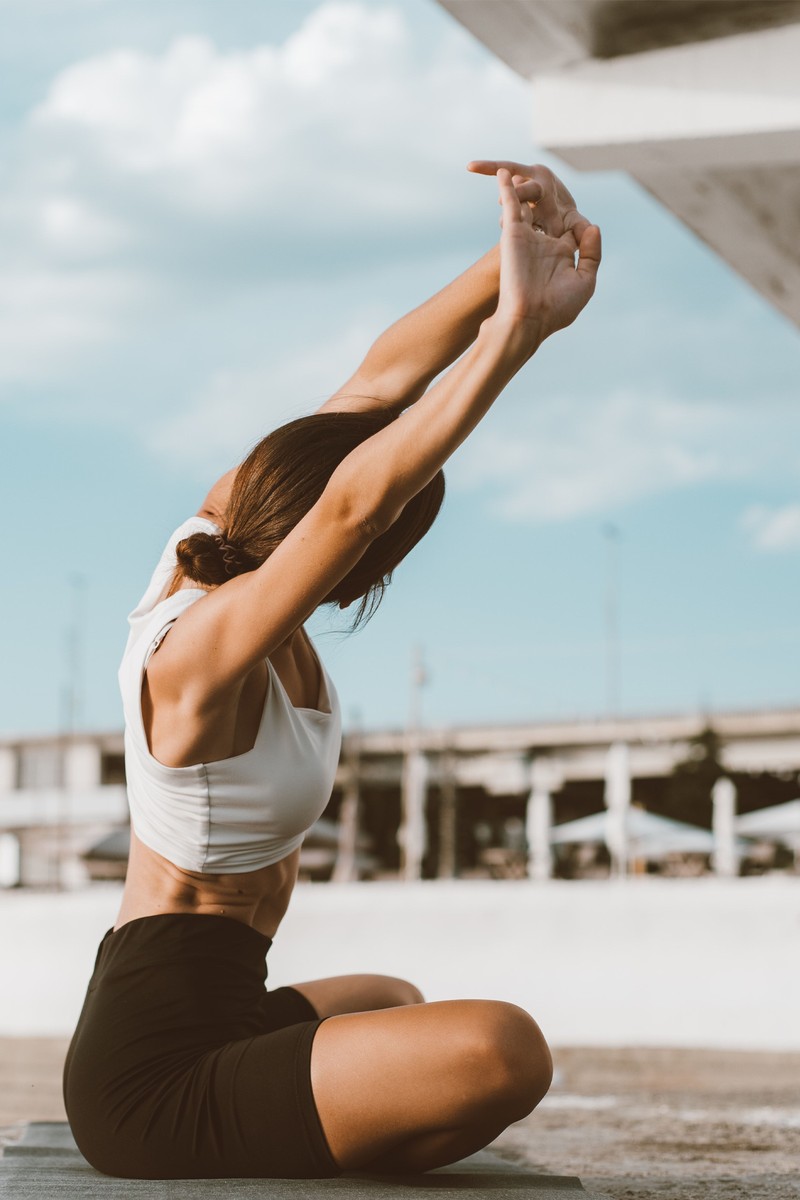4 Fitness Experts Share Their Tips For Better Posture
Marsha Lindsay,
Creative Director At Nobu Pilates, says…
A Lack Of Mobility Is The Latest Epidemic
“The modern world is geared towards sitting and minimal movement. The fact things are more interactive on a digital front doesn’t help, either. The repetitive action of dropping your head to your phone can quickly lead to chronic aches and pains around the neck area – this is one of the most common issues I see with clients. A lack of movement also contributes to weakness and tightness around the upper back, while weak abs lead to lower back pain as the lumbar spine isn’t correctly supported.”
We Tend To Have A Dominant Side Of The Body
“It’s not uncommon to have imbalances between the muscles on the left and right side of the body – we all have a dominant side. However, the difference between each side should be minimal, and the right type of training can bring the body back into equilibrium. At the same time, many of us struggle to plant ourselves evenly through our feet. Our feet are the most loaded part of our body and most of us don’t dedicate the time to regular maintenance. This can lead to poor hip alignment.”
A Foam Roller Is Great For Muscle Maintenance
“The body is clever – it will always tell you when something is wrong, so get into the habit of listening to your body. Any aches or pains connected to the spine tend to be linked to poor posture. Depending on the level of discomfort, the solution for this can be as simple as incorporating strength and stretching into your routine. With this alone, you can often see a significant improvement in your symptoms. Aches and pains around the neck and shoulders are obvious signs you need to dedicate more time to stretching and mobility. Keep a tennis ball under your desk to ease tension in your feet and foam roll regularly. If you have a massage gun, use it at least twice a day.”
A Balanced Approach To Fitness Is Best
“If you stand a lot for work, or lead an active lifestyle, get into the habit of actively thinking about your posture when standing. Keep your shoulders back and down, and your neck upright to avoid ‘tech neck’. Roll your feet as frequently as you can and pull your abs ‘in and up’ to support your lower back. Look at your week of movement and make sure you’re covering the bases: weights, cardio, mobility and stretching – this is the winning formula for a stronger body and better posture.”
David Wiener,
Training & Nutrition Specialist At Freeletics, says…
Headaches Are A Sign Of Poor Posture
“If you sit at a desk all day and are prone to headaches and migraines, this could be a sign of poor posture. When you slouch over a screen all day in a forward hunching position, this ‘tech -neck’ posture can lead to aches and pains in your back, neck and shoulders, as well as headaches. A poor sitting posture also increases the curve in your mid-back, which can throw the muscles around your neck, shoulders and spine off balance, radiating to your head and causing headaches. Slouching with your head forward also puts more pressure on the muscles at the base of your skull, which can trigger a tension headache.”
Moving Regularly Will Aid Blood Flow
“Moving more throughout the day is one of the most important and effective things you can do for your posture. Taking shorter, more regular breaks throughout the day is more beneficial than fewer longer breaks. Get up to move and stretch every 20 minutes if you can, and at least once per hour. If you work from home, ensure you are doing some form of physical exercise either before or after the workday.”
Think About Pulling Your Shoulders Back
“When standing, make a conscious effort to ‘stand tall’. One of the simplest ways to do this is to pretend you’re standing against a wall, keeping your head straight and chin tucked under. Pull your shoulders back when you’re on the move, too. Proper posture can increase your body’s intake of oxygen by up to 30%, making you feel more energised and alert. Standing tall also helps your internal organs to align correctly, keeping everything working as they should.”
Sleep Is A Factor
“You many not give your sleeping posture much thought, but the muscles and ligaments in your back relax and heal overnight, and giving them adequate support to do so matters. A quality mattress that provides support for the natural curves of your spine is important, as is a pillow that supports the natural curve of your neck. Avoid anything too high or too low, and remember extra pillows can be used to support certain sleep positions – such as a pillow in between your legs if you sleep on your side – and help to keep the body in proper alignment.”
Strength Training Will Help
“Using weights to strengthen the chest, back and glutes can have a positive impact on your posture. The posterior chain includes all the muscles that run from your foot through your calves, along the back, through to the lower back, along either side of the spine, and finish under the skull – think of it as the body’s foundation. A weak posterior chain can lead to slouching and poor posture, as well as a tight chest. Plus, without strong back muscles, you’ll struggle to pull back your shoulder blades back to keep you upright. Include compound moves that work multiple muscle groups simultaneously, such as squats, glute bridges and reverse lunges. A deadlift is also a great move for better posture as it improves lower-body strength and supports muscles around the hips.”
Visit Freeletics.com

Matthew Glithero,
Musculoskeletal Specialist At Wellthy Clinic, says…
Stress Takes A Toll
“When we are stressed, the body goes into fight or flight mode, which triggers the nervous system to send signals to the musculoskeletal system to tighten, effectively preparing the body to run from a threat. The problem is, when this stress mechanism is maintained for longer periods of time, muscles become overly tight – your shoulders lift and your respiratory rate increases, which leads to shallow breathing, causing the diaphragm to tighten, which consequently reduces thoracic mobility. Combined with a sedentary lifestyle or sitting for long periods, this can lead to posture problems such as a hunched back.”
Tight Fascia Plays A Part
“Fascia is a structure of connective tissue that holds the body together – it surrounds groups of muscles, nerves and blood vessels. However, fascia is clever and adapts to postural habits to protect itself. When fascia becomes stuck, it squeezes whatever is around it, including nerves and blood vessels, which can lead to pain. Research shows fascia plays an important role not only in our posture but also balance and coordination, and that unhealthy fascia can lead to muscle tightness and stiffness, and limit mobility. Regular stretching and a low-impact strengthening form of exercise like Pilates will support fascia and posture.”
Your Desk Setup Matters
“Although many of us are now back working in an office environment, poor posture habits are still rife. If you hot desk and use a laptop, invest in a separate keyboard, which will allow you to raise the height of your laptop so the screen is in line with your forehead and the keyboard is lower on the desk. Sit with your feet slightly apart, possibly using a lumbar arch support, with your knees at 90º and feet flat on the floor. Your shoulders should be relaxed, and your elbows supported.”
A Warm-Up & Cool-Down Are Essential
“Before any workout, ensure you do at least five minutes of active joint mobility – this should include dynamic movements that will prepare the body for your workout and minimise your chance of injury. Key body parts to keep in mind include your shoulders, neck, spine, hips and ankles, and proper breathing. Post-workout, cool down with static stretches to aid blood flow and restore optimal posture.”
Visit WellthyClinic.com
Aimee Pearce,
PT, says…
Your Feet Are The Foundation
“When we think of posture, we tend to think only of the back and spine, although posture is a head-to-toe issue. The feet are the foundation of our body, and the arch is the structure that holds everything upright. Poor footwear is often the cause of postural problems and back pain. High heels will shorten your calf muscles over time, leading to lower back pain and poor posture, so take a break from heels where you can. Also consider spending time barefoot – this can have a positive impact on your knees and hips.”
The Spine Was Designed To Move
“Our bodies are meant to move and the spine is supposed to flex and be mobile, emphasising the importance of moving regularly throughout the day. When you have good, strong posture, your body is correctly aligned. Good posture is having the strength and flexibility in your muscles and joints to stand, move and sit in an efficient way without putting additional strain on the body.”
Some Pressure Is Beneficial
“Modern living is designed to make us comfortable, so our body never gets enough pressure exerted on it. Counteract this through gentle stretching, sports massage, sitting on the floor and foam rolling. Anything that puts the body under pressure will increase blood flow to the muscles and support better posture. If you are working at home, try moving your laptop to a sofa while you sit on the floor – your hips and glutes will thank you – and stand up while taking phone calls to encourage movement.”
Visit Insure4Sport.co.uk
DISCLAIMER: Features published by SheerLuxe are not intended to treat, diagnose, cure or prevent any disease. Always seek the advice of your GP or another qualified healthcare provider for any questions you have regarding a medical condition, and before undertaking any diet, exercise or other health-related programme.
DISCLAIMER: We endeavour to always credit the correct original source of every image we use. If you think a credit may be incorrect, please contact us at info@sheerluxe.com.


